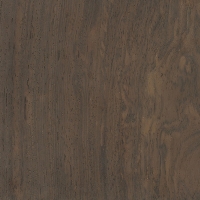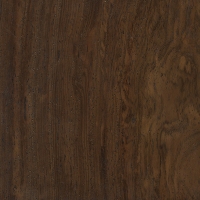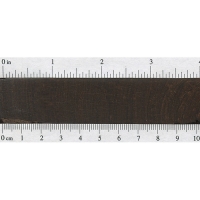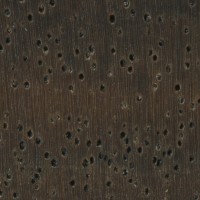 |
Common Name(s): Leadwood Scientific Name: Combretum imberbe Distribution: From South Africa north to Tanzania Tree Size: 32-64 ft (10-20 m) tall, 1-2 ft (.3-.6 m) trunk diameter Average Dried Weight: 76 lbs/ft3 (1220 kg/m3) Specific Gravity (Basic, 12% MC): .96, 1.22 Janka Hardness: 3,570 lbf (15,880 N) Modulus of Rupture: 20,960 lbf/in2 (144.5 MPa)* Elastic Modulus: 2,494,000 lbf/in2 (17.20 GPa)* Crushing Strength: 9,950 lbf/in2 (68.6 MPa)* Shrinkage: Radial: 2.0%, Tangential: 4.7%, Volumetric: 6.8%, T/R Ratio: 2.4* *Strength and shrinkage values are for the closely related Combretum schumannii |
Color/Appearance: Heartwood is a rich, reddish brown to dark brown; color darkens with age. Clearly demarcated sapwood is a pale yellow.
Grain/Texture: Knots and other grain irregularities are not uncommon. Fine uniform texture.
Endgrain: Diffuse-porous; sometimes exclusively solitary; large pores sometimes arranged in radial/diagonal patterns, very few; heartwood mineral/gum deposits common; parenchyma vasicentric and lozenge; narrow rays, spacing fairly close to close.
Rot Resistance: Reported to be very durable, with excellent insect resistance and weathering characteristics.
Workability: Generally difficult to work on account of its density; sharp cutters must be used to avoid tearout. Can also give problems in gluing and finishing. Turns superbly.
Odor: No characteristic odor.
Allergies/Toxicity: Although there are no specific reports on Combretum imberbe, other species in the Combretum genus (particularly C. kraussii) have been reported to cause skin irritation. See the articles Wood Allergies and Toxicity and Wood Dust Safety for more information.
Pricing/Availability: Not offered very often for sale, Leadwood is occasionally available as turning blanks and small lumber. Prices are likely to be high for an imported hardwood.
Sustainability: This wood species is not listed in the CITES Appendices or on the IUCN Red List of Threatened Species.
Common Uses: Carving, furniture, turned objects, and other small specialty items.
Comments: Smaller trees are used as fuelwood, as the wood burns slowly at high temperatures.
None available.
Scans/Pictures: A special thanks to Rory Wood for providing the facegrain sample, as well as Steve Earis for providing the 10x engrain sample of this wood species.








Is leadwood and mgrure more or less interchangeable or are there significant differences between them?
My extraordinarily heavy 24″ leadwood bowl. I made an angle iron ring with cast iron casters to move this 100# beauty around!
Thank you for a very useful database!
Just finished turning this from Leadwood.
I live in Zambia and use the wood regularly. It is great for turning but very hard even green. If it fully dried it will break tools, including carbide. I turn vases and lamps sanded down to 800 and it doesn’t need anything on it. No wax, varnish, or oil. The wood is so dense it shines beautifully. I have noticed it is susceptible to cracking but I keep CA glue on the lathe and when i notice cracks appearing I hit it with the glue and it usually stops them in their tracks. We have trees in the 55+… Read more »
Thank you for the info.
Thanks, Derrick for the additional comments.
As regards odor:
To me it has a pleasant characteristic odor.
Very noticeable sweet, spicy smell when worked.
Its smoke is also aromatic.
It does turn very well, if cutters are sharpened regularly.
In South Africa it is now a protected species, though not CITES listed.
very informative, I have a watch which has Leadwood in the strap and bezel, looks very nice
is it a Holzkern?
Hi Victor
sorry for the delayed response, yes it is the Holzkern Kay Model
Danny,
I also ordered a Holzkern watch with leadwood. I’m wondering what I can put on the wood to protect it from rain, etc… Turtle wax? Some kind of oil?
Thanks for the information Derrick, very useful.
What finishing would suggest? Wax?
very usefull
Hi Derrick
Thank you for this valuable information
Regards
Chris de Beer
Sorry Eric, your post did not reflect before.
The timber is very strong but brittle, rigid in short lengths but not so rigid when long. When grading the mill must understand the way the tree grows. The nature of the tree is very erratic and the branches break off easily. Unfortunately the tree grows around the knot and often leaves cavities which are often concealed. It also suffers from shake, mostly at the base of the tree near the center. Once again dependent on the mill and their ability to understand where to look for faults. When machining you get a combination of fine powder-like dust and normal… Read more »
To whom it may concern.
We are based in Mozambique and are busy making all the windows, doors an furniture out of Leadwood, or as we know it Monzo.
Would you be interested in some info that is missing from your site?
Regards,
Derrick.